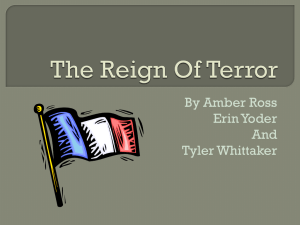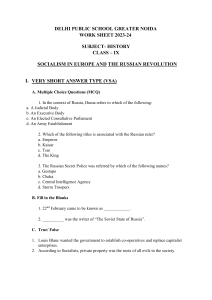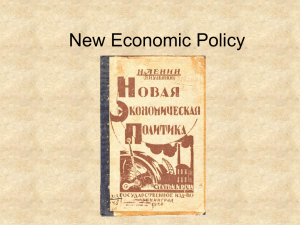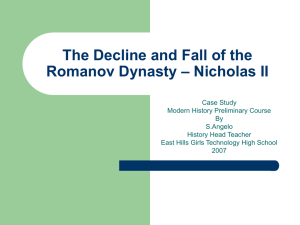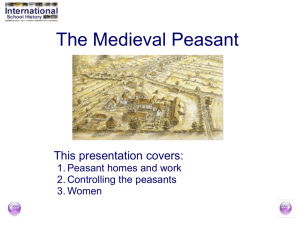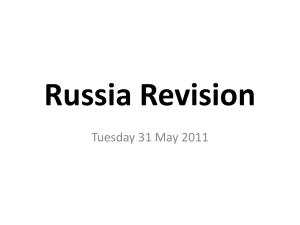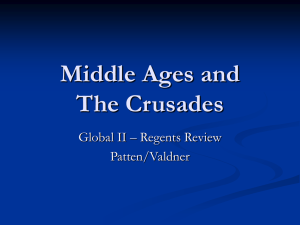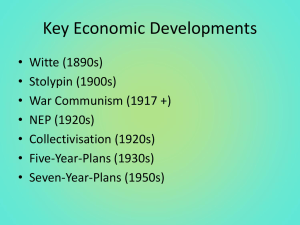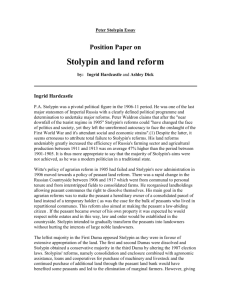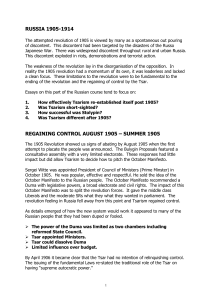Economic Changes - bedstone
advertisement
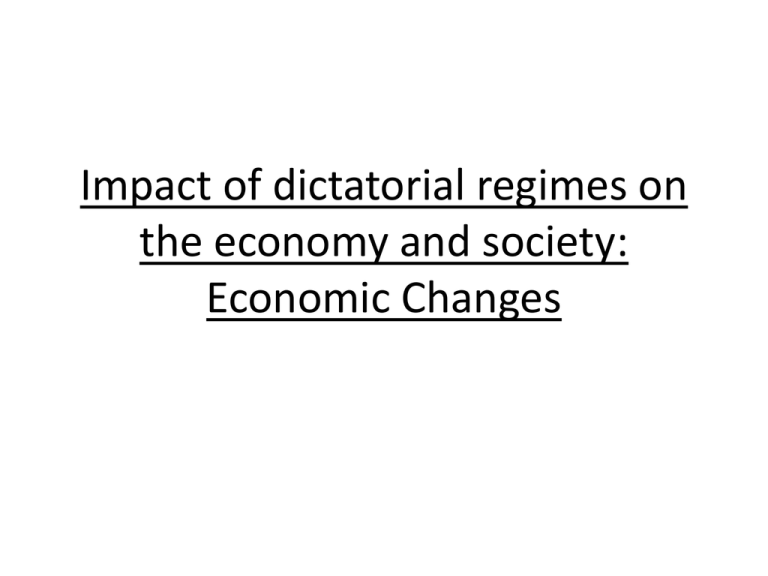
Impact of dictatorial regimes on the economy and society: Economic Changes Economic changes 1. Describe the Russian economy before 1855 2. State and describe three problems that hinder the development of industry in Russia 3. What policies were used to industrialise Russia during the Great Spurt 4. What was the mir and how did it impact upon economic development? 5. Why was NEP a controversial economic policy? 6. What is hyperinflation? 7. What is the difference between Kolkhoz and Sovkhoz? 8. Why were five year plans effective? 9. Was the virgin land campaign effective? 10. Compare the economy from 1964 to the start of the course, 1855. What are the main developments in the Russian economy? 1855-1881 • Russian industry virtually non-existent and agriculture very traditional – development of industry by middle-class, or even by aristocracy, unlikely to occur due to a) lack of middle class and b) suspicion from aristocracy • Few efforts from peasants or landowners to modernise • Lack of industry / predominance of agriculture affected all areas of life – mir, zemstvo, no desire for economic change (failure of ‘to the people’) • Serfs emancipated in 1861 • No “economic emancipation” – freed peasants often in debt, often fall behind on redemption payments and were often allocated poorer-quality land than before. • Lack of the geographical and political requirements for an industrial revolution – no middle class, little coal, few consistent rivers, no interest or investment from upper class 1881-1905 • Witte’s Great Spurt: got foreign loans, raised taxes and increased interest rates. Joined gold standard. Built railways • “Save Russia through rapid and forceful industrialisation” • By 1900, 20% of Russian budget is just paying off loans. Light industry virtually ignored. Railways often single track or incomplete • Nicholas II believes Russia will defeat Japan due to the Great Spurt • Redemption payments for serfs reduced (1881); peasant land bank set up (1883); peasant poll tax abolished (1887.) • Land captains appointed – could overrule mir • Grain exported to fund industrialisation causes famine (1901); 1,000,000 die • In 1893, a tax law allowed the mir to raise taxes. This stopped attempts by Russian businessmen to develop their enterprises (although that was not the aim) 1906-1913 • Military spending dramatically increased- Further foreign loans • Strikes decrease; health insurance introduced; trade unions legalised • Stolypin’s Wager on the Strong – improves Land Bank • 2,000,000 voluntarily settle in Siberia; as many again set up independent farms. “By 1914, the agrarian crisis seemed like a bad dream” (Gatrell, historian) • Western industries and economies grew much quicker • Some strikes were brutally put down (Lena gold fields, 1912) • Only 5% of Russians were industrial workers – vast majority were still peasants • Stolypin said his wager needed “20 years of peace” to work. It got 3. Stolypin’s reforms arguably divided the peasantry and created tension • Agricultural growth was a poor 1% per year 1914-1918 • The Provisional Government increased income taxes and created a New Economic Council • The railways were unable to supply soldiers effectively (or at all) • Wages fell 50% but the price of bread increased 300%. The response of the Provisional Government was to print more money, meaning Hyperinflation • As prices meant so little, peasants simply grew enough for themselves • 1,000,000 were threatened by starvation • After February 1917, peasants started seizing land for themselves. The Provisional Government didn’t endorse this, but was unable to stop it 1919-1920 • War Communism • Industrial workers supported the Reds and Lenin used factory committees to set economic targets: improved production figures in industries: guns and munitions • “Peace, bread, land” was popular with peasants • 80% of peasants who were forced to join the White Army deserted • Lenin replaced worker’s councils with skilled, bourgeoisie specialists • By 1920, industrial production was about 14% of the 1913 levels • Grain shortages led to serious famine – 6,000,000 had died by 1921 1921-1927 • Due to the Kronstadt Uprising, Lenin introduced NEP – small scale capitalism • By 1923, NEP allowed the grain harvest to rise 50% and the worst of the famine was over • Trotsky’s “Scissors Crisis” occurred – industrial prices rose, agricultural ones fell (this meant that peasants' incomes fell, and it became difficult for them to buy manufactured goods. As a result, peasants began to stop selling their produce and revert to subsistence farming, leading to fears of a famine) • Was NEP the New Exploitation of the Proletariat? • Nepmen, those who did well out of NEP, were resented, especially in the countryside 1928-1940 • First Five Year Plan – economic growth doubled whilst the rest of the world was in Depression • New railways laid • Industries developed in the heart of Russia (useful in WW2) • Kolkhoz (collective farms) and Sovkhoz (state farms) set up from 1927. Motorised Tractor Stations established • Type of goods limited; military or industrial, not consumer • Quality of goods questionable at best • Methods of production (forced labour) were not particularly communist • Kulaks killed their animals rather than hand them over • Agricultural production did not reach level of 1928 until 1953 • Stalin was inconsistent. Kulaks persecuted (until 1930), then not so much (1930) then again (1931) 1941-1945 • • • • • • • • New cities founded based on economic need (Tankograd) Foreign loans, mainly from America, help industry Russian industry moves east War could have been worse; Five Year Plans meant there was some preparation 25% of all industry was destroyed; production levels fell 70% Strongest farm workers conscripted into army Western provinces devastated in German advance 100,000 large farms (65% of all state/collective farms) destroyed 1946-1953 • USSR loots or ‘claims’ vast amounts of equipment/material from Germany • Fourth Five Year Plan aims to re-establish heavy industry/build up defence • By 1950, production ahead of pre-war levels and big projects like the Dnieper Dam were working again • Ambitious plan for ‘agro-cities’ and ‘the transformation of nature’ • Citizens working 12 hours a day; rationing maintained; rouble devalued by 90% • Few consumer goods • Farms and countryside simply seen as the way of providing the cities • State seized up to 70% of harvest on occasion 1954-1964 • • • • • • • • Seventh Five Year Plan focuses on consumer goods Farming decentralised Khrushchev put emphasis on agriculture Virgin Land Scheme produces 50% of all the harvest in 1956 Agricultural wages double Consumer goods created, but of poor quality Party divided over Khrushchev’s agricultural policy Stalin’s era was found to have had less grain than the era of Nicholas II • Tractors broke after being sold and could not be repaired • Mistakes in Land Campaign (wrong seeds for the soil) meant that the 1963 harvest was 35% less than anticipated • Private farms were only 3% of land but produced 30% of the total harvest
